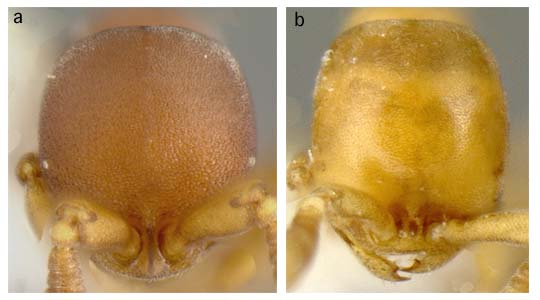
| Genus List | Species List |
Discothyrea is a very distinctive genus of tiny, generally eyeless ponerines (Brown 1958). The fourth abdominal segment is vaulted and directed anteriorly (a condition shared with Proceratium and some Gnamptogenys). The antenna has a club formed from a single, large terminal segment. The antennae are closely approximated. In all Costa Rican species there is a flat lamella projecting vertically between the antennae.
Number of antennal segments has been used as a species-level character in keys by Weber (1939) and Borgmeier (1949). But counting antennal segments on small Discothyrea is very difficult, and its use as a species-level character has been questioned (Brown 1958). The scape, basal funicular segment, and terminal club are large and easily seen. The remaining funicular segments are small, ring-like, and may show partial fusion. In spite of the difficulties in counting, I have still found the number of these small segments a useful character for separating species within Costa Rica, especially in conjunction with the shape of the interantennal lamella. In humilis and JTL-004 there are four distinct segments. In horni, testacea, and JTL-002 there are more than four, but it is often difficult to determine if there are five or six. On some specimens it may even appear that there are five on one side and six on the other. In the SEM of the antenna of horni, it looks like there are five of the small funicular segments, but close inspection reveals what may be the partial separation of the bottom segment into two. Thus, in the key, I separate species that have 7 antennal segments (including the scape) vs those that have more than 7, but I do not try to further specify segment number in the latter group.
The other main character system I have used to distinguish Costa Rican species is the shape of the clypeus. Features to examine include: (1) in face view, the profile of the anterior margin, (2) in lateral view, the degree of forward projection of the clypeus beyond the mandibles, (3) in lateral view, the profile of the interantennal lamella, which may be subrectangular, subrectangular with a dentate anterior margin, or subtriangular.
10a. Antennae 8-9 segmented; interantennal lamella subrectangular in lateral view: 100
10b. Antennae 7 segmented; interantennal lamella subtriangular in lateral view: 200


100a. In face view anterior margin of clypeus shallowly convex to flat; interantennal lamella usually lacking an anterior tooth in side view; color red brown to nearly black (antennal club contrastingly yellow on dark specimens): horni
100b. In face view anterior margin of clypeus more strongly projecting, subtriangular; interantennal lamella with or without anterior tooth in side view; color light orange to red brown: 150

150a. Head width 0.47mm (n=1); interantennal lamella lacking anterior tooth in side view; color red brown: JTL-002
150b. Head width less than 0.40mm; interantennal lamella with distinct anterior tooth in side view; color light orange to red brown: testacea

200a. Face densely punctulate, mat; interantennal lamella relatively larger, with ventral margin originating at anterior border of clypeus, such that in side view ventral portion of lamella is usually visible; clypeus projecting relatively farther beyond mandibles: JTL-004
200b. Face sublucid; interantennal lamella relatively smaller, a tooth originating between antennal insertions, well above anterior margin of clypeus, such that in side view lamella is usually not visible, obscured by antennal scapes; clypeus projecting relatively less beyond mandibles: humilis

Literature Cited
Borgmeier, T. 1949. Formigas novas ou pouco conhecidas do Costa Rica e da Argentina (Hymenoptera, Formicidae). Revta Bras. Biol. 9:201-210.
Brown, W. L., Jr. 1958. Contributions toward a reclassification of the Formicidae. II. Tribe Ectatommini (Hymenoptera). Bulletin of the Museum of Comparative Zoology 118:175-362.
Weber, N. A. 1939. New ants of rare genera and a new genus of Ponerine ants. Ann. Entomol. Soc. Am. 32:91-104.
Page author:
John T. Longino, The Evergreen State College, Olympia WA 98505 USA.longinoj@evergreen.edu